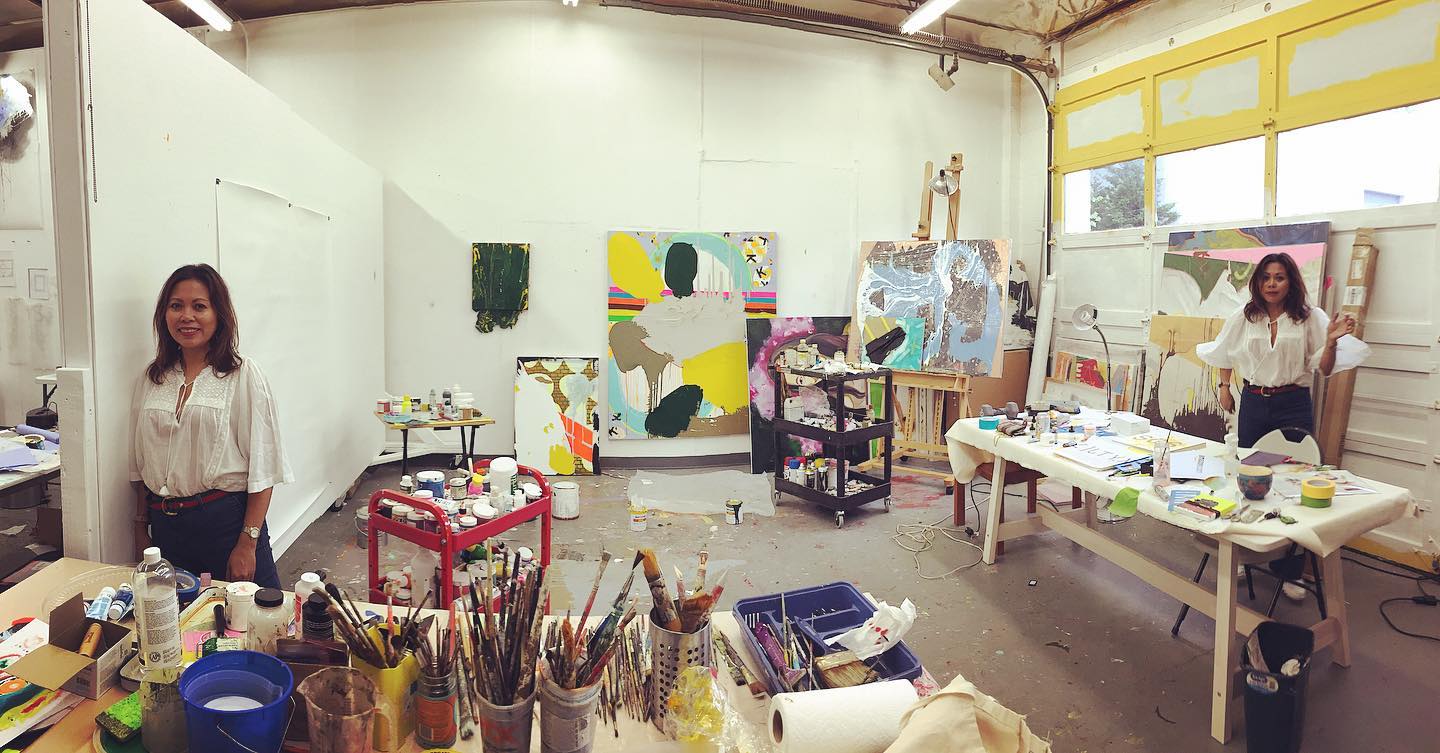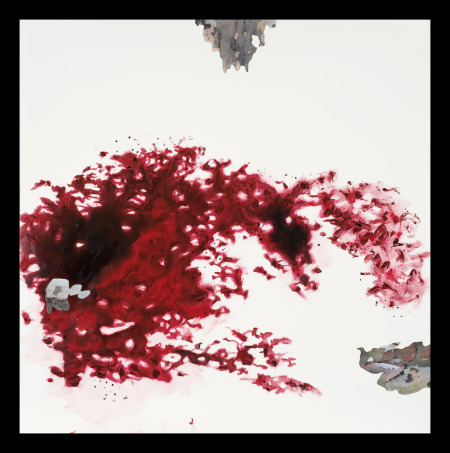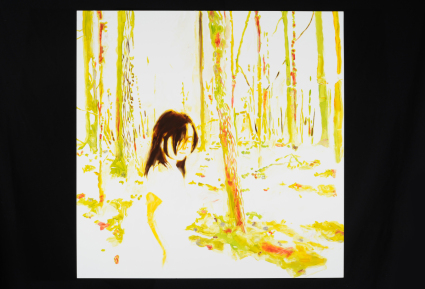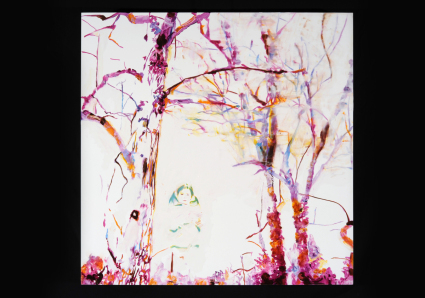________________________________________________________________________
Endurance 2025
The current work I’m calling “Endurance” is figurative and iconographic and depict the female body in compositions that make reference to symbols. Specifically, I am interested in exploring the logic of symmetry inspired by Christian Byzantine iconography through the female form.
The body of a woman is historically insignificant and if anything, something to be ashamed of in the Catholic faith. It is a symbol of original sin. When the Philippines was colonized by the Spanish Conquistadors and violently whipped into submission to adhere to the faith, Filipinos and in particular Filipino women, began the hundreds of years of pain and abuse perpetrated by the Catholic Church. And yet we continue to persevere and endure in spite of the intergenerational trauma of undergoing such an oppressive colonization.
The rope is a powerful object that symbolizes the constraints and oppression Filipina women and women of color experience personally and politically to this day. It is meant to represent the bondage and pain that is experienced while simultaneously signifying the strength and will to endure within the hostility of patriarchal impunity that knows no boundaries. It is the stillness in these bonded postures that imply endurance. Included with the figures are punctuation marks, characters from the pre-colonial alphabet of the Philippines, and mathematical symbols that ironically serve as a lexicon of pictorial clues. If our very existence won’t be validated, perhaps at least the representation of our bodies can be witnessed as a a form of pictorial and linguistic resistence and truth.
ISABEL MANALO, 2025
Artist Statement November 2023.
The people in my family are steadfast subjects for my portrait work. I am interested in depicting their faces not just as representations of those who I care most about, but in order to reveal their stories as Filipino Americans within a greater ethic diaspora. My daughters who are now ages 18 and 20, have been consistently present in my paintings since they were born. Motherhood and making drawings and paintings became a path to archive their growth and evolution as human beings. I am inspired by my role as their mother and to witness their awesome development into young women has been and continues to be such a privilege. More recently, I have been delving into the stories of my parents. My dad who passed away in 2020 and now my mom with dementia who lives with me as her main caregiver. The approach to my painting is akin to documentation. But rather than using a camera, I delve into the love for the oils and how the paint abstracts and transforms each individual to a reveal another truth of who they are.
Curator’s Statement, January 2023
“Holy Inventions”
I have had the pleasure of knowing Leo Bersamina, Tom Bunnell, Cheryl Edwards, Ian Jehle and Caitlin Teal Price personally and professionally for many years, through the many overlapping roles we hold as visual artists. It is through these many deep and lived experiences I have with each one that inspired this show titled “Holy Inventions”. Each of these artists are practicing in their art a mindful and creative trajectory that falls within a system of laws they have designed for themselves over a period of many years. And because of the contrast and similarities between each of their work, I am excited to be able to bring them all together in one space that is so familiar to me. The space of Addison Ripley Fine Art Gallery in Washington D.C. A space that is akin to an art home where I have had the privilege of exhibiting since 2007 as an artist myself.
When we speak of visual language, it conjures up genres of art as well as medium, content, mark, and other formal devices used by artists to express themselves. I find it interesting to think of the visual as something still framed within a linguistic ethos which most associate with verbal languages. However, it is apropos to accept this description because as artists, we do work within our own pictorial worlds and universe and within them, we design our own grammar that become the characters, time, space, light, color, ideas, life and whatever else we choose to populate them with. There exists a structural design where we are able to express our own stories, and it is the artist's prerogative to create whatever rules they want to abide by.
When I look at art, I find the system of this language- of what each artist has invented- to be what brings forth their most genuine and sincere self. What I am seeking and have seen in these five artists is a dedication to true invention. Invention from an exploratory mode of discovery that one associates with scientific laboratories, and not always with the artist’s studio. I believe good artists embody the minds of a philosopher, psychologist and anthropologist all at the same time. These disciplines, as with art, require a keen dedication to a long term investigation and a true commitment to exploration and discovery.
While each of these five artists makes reference and reverence to historical canons, each of them have devised and engineered a system of research that expresses a language that for me, is holy.
Holy as defined by the Merriam Webster dictionary as well as Wikipedia is:
1 Worthy of complete devotion and trust
2 Divine
3 Set apart to the service of God or a god : sacred
4 Respected as sacred.
In this context of holy, it is about trust. Oftentimes when we enter an art museum, we are encountered by that sensibility of worship akin to entering a church; something sacred. There is this obligatory devotion visitors subjectively encounter as they cross the threshold of the hallowed halls of art history or contemporary art. What I am touching on here with these five artists, is not that kind of religious holiness or anything transcendent, but rather a grounded connection to their process through which they genuinely create that imbues not only authenticity, but trust.
What these five artists share is a collective drive for truth in their art. There is so much at stake today, 2023. Too many artists approach their work with fear, with hopes of attention and simple Capitalist intentions. I am thrilled to present these five artists because of their ability to create work that is confident in their voice, their process, and their ideas as it speaks not just to truth, but IS truth.
Leo Bersamina derives his forms from nature and reinvigorates both geometric and organic patterning with earnest compositions and installations that visually affect the viewer with rhythm and flow. Whether we are confronted by a giant mural, or a small painting, Leo’s ability to scale up and down, and to create multiples, is indicative of his responsiveness and ability to adapt his work to the context of where it will live. As an ardent adventurer of the great outdoors, Leo is a witness to the patterns of the natural process of life and death. He seizes these moments to create and invent patterns that energize optically, as well as texturally.
Tom Bunnell’s wondrous motifs he carefully places and shifts within planes of sumptuous colors are complex and poignant. I have always known Tom to be one of my most emphatic ‘painter’s painter’, making references to Modernist artists who have destroyed all notions of illusionistic space and light. He discovers his world from under his eyelids, or the spaces in between and what is not meant to be seen. They reveal a world of beauty, empathy and poetry with fervent factual existence with every brush stroke he makes. His work is him.
Cheryl Edwards potent renderings of Egyptian paddle dolls enters a multi-level interpretation of what is important to her in reference to ideas of genetic memory as they connect to African and African American identity. Her work depicts the paddle dolls, an ancient form of musical instruments, in full chroma as if they are being shaken to their core and brought back to the present from the ancient past. They are bold, shouting from above, and daring us to care by personifying each of these renderings with an identity. A name. A place in time. A history of consciousness that she states:
“I have determined in this stage of my artmaking, post pandemic, that
my accessing of ancestral memories has facilitated a shift in paradigm
of consciousness. Honestly re-considering diversity and humanity on a
fundamental, foundational level.”
Ian Jehle’s mathematical systems of constructing his abstractions from the existing machine made patterns of the masonite surfaces in which he chooses to work off of, recall conceptual artist Sol LeWitt. Like Lewitt, it is the process driven ethic that matters here. The result of his engineered process is an interplay of color and organic shapes that for him symbolize people and landscapes. Using soft tints and hues, the inherent shards of wood embedded within the material come forth out of the tan monochrome where they collectively begin to form shapes that reference natural forms from nature. In a way to break up the plane, he includes notations of codes that recall symbols from mathematical calculations.
Caitlin Teal Price’s scratched photographs are cerebral and illusionistic manifestations of light. The interplay between the surface of the photo paper and the hand made mark are violent and delicate at same time. When viewing her works, they seem to shift and move in front of you as shards of light seem to spark into reality off the photograph. I am reminded, adjacently, of painter Agnes Martin. Her meditative and sparse canvases beg you to contemplate the works for long periods of time in their controlled and repetitive mark making. While Agnes Martin made works that were about the presence of absence, Caitlin Teal Price’s marks remind us of the weight of each indelible scratch as if to mark time passing. There is a verisimilitude to sewing a stitch by hand, rhythmically for eternity leaving its permanent tattooed mark.
There is truth in the knowledge that these artists and their deftly made works are all working in conversation within a framework that for me, is forever enduring, questioning, and rigorously everlasting in our visual and cerebral memory. Not transcendent, but firmly grounded in their corporeal humanity and existence as inventors of artwork that speaks volumes to an individual truth, that in the end connects us all and ultimately will remain within the archive of our cultural and societal milieu.
Isabel Manalo, 2023
2021/2022
Lately painting for me has become a release and expression of my drawing process. That which is more immediate, gestural, imperfect and ephemeral and yet still driven by a highly saturated palette and layering of marks and pattern.
"To Grow A Child" engenders the growth and development of the bonds I have with my late father, my teenage daughters, and my mother who suffers from vascular dementia.
Images of faces and bodies comingle with familiar plant life and foliage and bouquets of flowers that have been given and received in all the exchanges of hello's and goodbyes. Cues from media of current events pop up as does the pre-colonial script from the Philippines. The compositions and drips are a reminder that these are just images, paint and color - a mode of expression that allows me to remember and recall the events of losing someone as well as a way to hold on to them. They are an attempt to create a metaphorical elixir to ease the curse of grief after a loss, a stab in the heart or a migraine spurred by tragic world events. The focus on those I care for and those who have cared for me is a reminder that growth is generational and cyclical. While there are droughts and downpours, the seasons still march on changing from one to the next. Blossoms still open up and then wither and die. While paintings are evidence of a process, it points tacitly at what is at stake and what we all must endure - an imperative to persevere.
2018/19
 Isabel in her studio, 2019.
Isabel in her studio, 2019.
This current abstraction work is driven by the divisions that are happening in our world today. It is a visceral emotional state of energy that is made up of disconent, anger, chaos and a palpable and almost ironic joy. The physical process of making these works is vital to this kind of expressionism. Each work has been started by one character from the Baybayin, the pre-colonial script of the Philippines. It's a way for me to empower the script in a way that is charged and visually meaningful. The works are historical and contemporary and endeavor to leave the audience feeling anxious and breathless. The hard edges against textured pours and rumpled skeins of paint are transgressive from the history of abstract expressionism - they are not beautiful in the typical standard of harmonious beauty in art, but they are cacophonous and harsh and meant to be slightly painful to view and to illicit quesitons of 'why'?
https://www.facebook.com/isabelmanaloartist/videos/700839040301725/
2016
My work is inspired by the ancient script called the Baybayin, a pre-colonial form of writing in the Philippines. It was a script abolished by the Spanish colonizers but has been rediscovered in the recent past. Many Filipinos are excited about it’s discovery and have been tattooing the script on their bodies and proudly displaying it in other art forms. I’ve always been inspired by the history of empire and imperialism and how the desire for power has affected those countries subjected to Colonialism in largely negative ways. I see the script as a positive light in the history of the Philippines -- evidence of a time when there was no Western Civilization or Catholicism that in essence was the Spanish Colonization that endured for over 350 years in the Philippines.
The script is based on Sanskrit and each character can be translated phonetically to form words in Tagalog, the national language of the Philippines. As the daughter of a Philippine Languages and Literature Professor, I have always spoken Tagalog -- even growing up in Madison, WI. I also taught Tagalog as a graduate student while working towards my MFA. The Baybayin first appeared in my work in 1996 around the time when it’s discovery was gaining public attention. I took a break from the script until just a few years ago. I started painting and writing the Baybayin again forming them collectively in patterns inspired by the ancient tradition of tattooing in the Philippines. I love the rhythm and decorative nature of the patterning in Filipino body tattooing. Since moving back to the U.S. after living in Berlin, Germany for three years, I’ve began to work again on gessobord again -- a stiff surface that allows me to pour, drip, splatter and spill paint in a way where it can be heavily layered. This is a process I have been doing since my college days well over twenty years ago and back then, inspired by the great Helen Frankenthaler.
Each piece begins with a Baybayin character and then layered by many more. The characters evolve to be integrated into a geography and topography of pools and lines of paint and negative space. I call this show “Unscripted, Naturally” because it is about using the script in a non-linguistic way that resolves into an image that makes reference to nature. The kind of nature that appeared in my work in the early 2000’s that is beautiful and foreboding all at once. (Romantic landscape painting).
“Unscripted, Naturally” brings together my love for language, calligraphy, collage and the process of abstract expressionism all together in this new suite of paintings as a dedication to my cross cultural heritage and identity as a Filipino American.

"If Only", Cut photographs and oil on yupo. 30" x 30", 2011/12.
On View at Addison Ripley Fine Art from March 10 - April 14, 2012 in a show titled "Bits of Elsewhere"
The following is an essay by Writer J.W. Mahoney in conjunction with "Bits of Elsewhere", April - May 2012, Washington D.C. Addison Ripley Fine Art.
I S A B E L M A N A L O ' S N E G A T I V E C A P A B I L I T I E S
"... several things dovetailed in my mind, & at once it struck me, what
quality went to form a Man of Achievement especially in literature &
which Shakespeare possessed so enormously - I mean Negative
Capability, that is when man is capable of being in uncertainties,
Mysteries, doubts without any irritable reaching after fact & reason."
John Keats (28 December 1817)
A capability is both a grace and a power - and what John Keats was suggesting is that accepting uncertainty, doubt, and Mystery on open terms can be an empowering grace. Modernity, in all its forms, has depended on Negative Capability ever since. So does Isabel Manalo.
As viewers, without looking for either "fact & reason," we're presented with evidence - wild biomorphic abstractions, images of her children in forests of bare trees, of a nature whose foliage has been irradiated by light so strong that it may have come from the detonation of an atomic weapon. And interspersed in her pieces are fragments of real photographs, so we're observing several worlds at once. And her compositions are sometimes fully abstract, so we might be comfortable just appreciating the play of beautiful and personally intensive forms and colors? We're supposed to be used to that, with contemporary art.
But that's not at all what Isabel Manalo's work is about. The wild range of wistful beauties in Isabel's artworks center around a very restless awareness. There is a firm relentlessness in this art, the feeling of an ongoing narrative, whose passionate privacy reveals itself only in what Isabel makes as her art. Referring to recent work, Isabel speaks of its carrying the uncertainty of desire and hope, and of her use of alizarin crimson and burn umber as colors symbolizing (her words) passion, pain, joy and solitude. So - with regard to Negative Capability - Isabel's intentionally offering clear uncertainties and mysteries, along with the feeling of a significant yearning toward something actively just beyond the picture plane...
The most salient quality in any artform that concerns itself with yearning - from Sufi mystic poetry to 1920's Delta Blues to Mark Rothko's chapel - is the active presence of absence. What's so alive - and so alluring - in Isabel Manalo's artworks is the sense that every element in the work could be a tracing, a reflection, a memory, or a vision - of or from some swiftly moving conscious being who's just out of sight, but whose invisible eye sees and draws out her visions. But who? Certainly - immediately - Isabel herself, but also, vitally, another presence, an Otherness, to which her work is (so privately) radically addressed, her Muse.
In Jungian psychology, this idea of an autonomous creative force in the psyche is called a daemon, pronounced like the scarier term, but as transcendently powerful, mostly usefully. And it's an existentially personal compulsion, not a demonic possession. Isabel Manalo's artworks express the radiant mysteries - requiring Negative Capabilities to both express and receive - that continue to emerge from her, in full pursuit of her Daemon...
J.W. Mahoney, April 2012
THE FOLLOWING IS AN ESSAY from 2008
Written by independent critic, writer and curator Deborah McLeod who is now the Founder and Director of Chroma Projects Art Laboratory in Charlottesville, VA.

In the fixed distance--blanched a sporadic white in the jewel thicket of Isabel Manalo's dappled and blistered trees--is the natural landscape of the hypothesis of No Place. Manalo provides hints of presences; children who silently populate its partly extant glens and forests to slip shyly through the watery-colored overgrowth, as pale pink, barely perceptible silhouettes. Like a more benign version of Nathaniel Hawthorne's "Rappaccini's Daughter," these children's innate perfection and innocence, nurtured in such a tempting garden of uncertainties and absences, might be subject to the diminishing atmosphere and decomposing glare that Manalo's vegetation endures, yet respond by becoming essentially eternal. DM, Baltimore City Paper
Isabel Manalo’s paintings possess an uncommon transcendence and mysticism. Yet they are essentially simple and familiar in their subject matter, often with her two young daughters engaged in exploration and wonder amid the natural world. Even when the scenes are left unpopulated, it is the phenomena of the natural world that has always guided this artist’s landscape imagery. Landscape is however just the beginning of what these dynamic transmissions of time in space envision.
Manalo’s manner of giving us the physical world we expect to find outside our door is to dematerialize it to a barely recognizable degree. She quietly explodes the information, removing much of its supporting structure, allowing a few brilliant and vital fragments in the expected places to keep her viewers grounded and happy. Her paintings may most consciously remind us on a naturalistic level of very early spring or late autumn, when only the boldest foliage and blossoms enter or exit, while the rest, unavailable, exist purely in nature’s mind.

Subconsciously, the crucial white space that consumes the rest of Manalo’s picture plane offers itself as a kind of immortal reassurance. White space is generally understood to represent infinitude, the unknowable or the uninitiated, states that nonetheless most nearly describe what we can genuinely perceive of our earthly relationship to The Sublime. It is this crucial infinite white space that is really the land our deepest questions, uncertainties, hopes and prayers, our very breath, lives in.
The skipping, jewel-like glances of vivid translucent color so musically applied to the picture plane meanwhile provide a sense of hopeful providence and even joy, but it remains to that living mutable white ground that is so utterly freeing inside Manalo’s unarticulated imagery to provide us with an ultimate prospective.
Whatever presents itself to us in the concrete always requires some form of reaction, responsibility or maintenance, even if simply as a painting – a thing that holds someone else’s thesis. Once it is beheld it asks for something. The art work we actually choose to live with all contains terms we wish to reciprocate. So its dissipation into a place we cannot access requires that it fall into the purview of some further caretaker. The gift of release from that is perhaps the particular divine provenance of Isabel Manalo’s painted worlds.
Deborah McLeod
2008
Independent Curator and Critic
